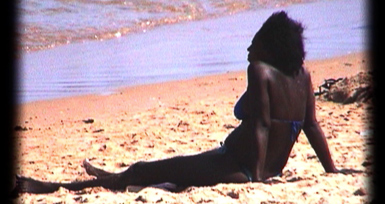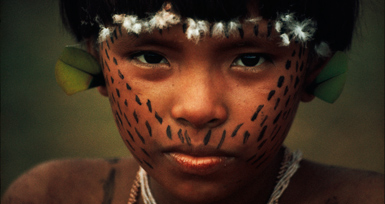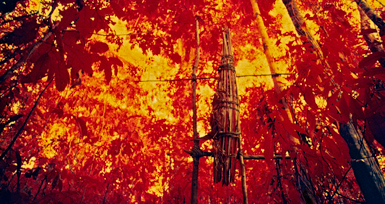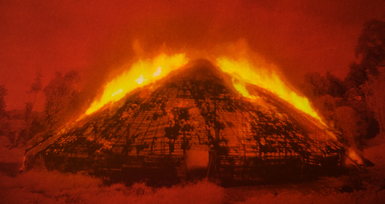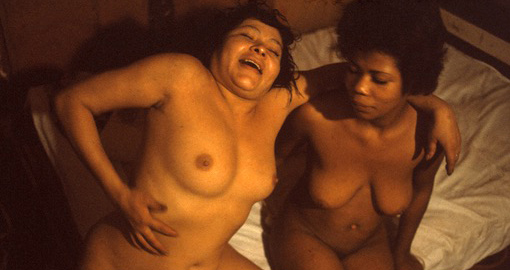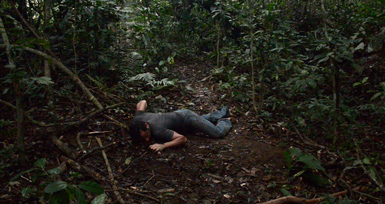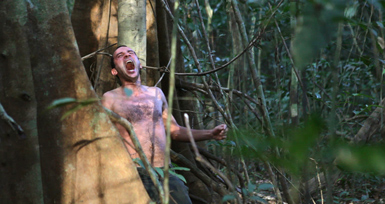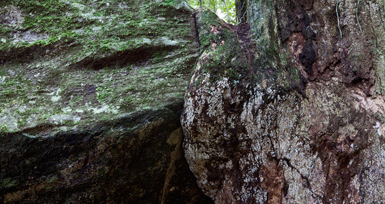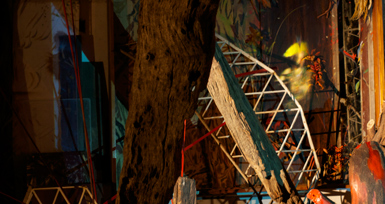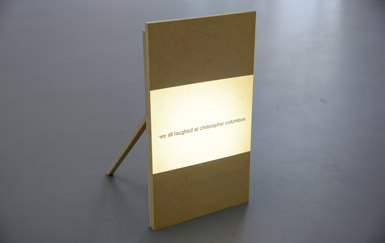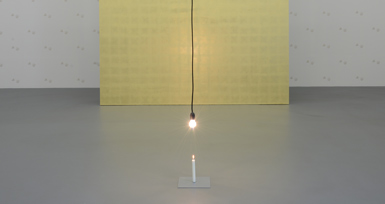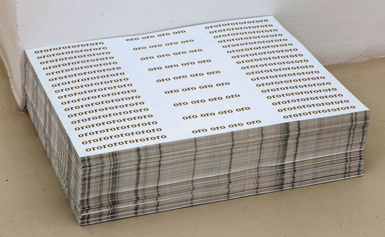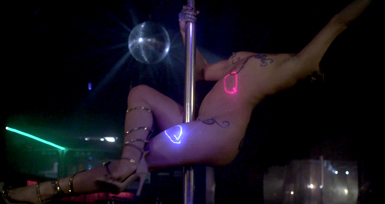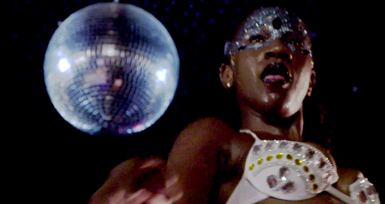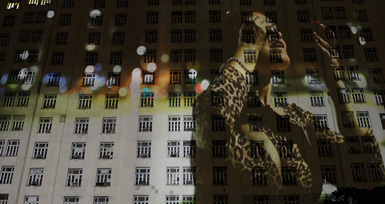The relations between body and identity and memory and belonging are some of the artist’s main research axes; he works with video, video installation, film, photography, installation, and performance. He was awarded at the 16th Sesc_Videobrasil Contemporary Art Festival (2007) with a residency at the Le Fresnoy, in Tourcoing, France. Some of the collective exhibitions in which he took part are Do Valongo à Favela, Museu de Arte do Rio de Janeiro (2014); the 3rd Bahia Biennial (2014); and the 29th Panorama da Arte Brasileira, at the Museu de Arte Moderna de São Paulo (2005). He lives and works in Salvador.
2005, video, 17’20”
courtesy of the artist
Uma is based on a chance event and is comprised of a single shot with no cuts, like the subjective view of a voyeur; it shows a man and a woman hugging each other in the water, at a beach. The choreography of those two bodies suggests that, at broad daylight and in front of everyone, they are making love—the “uma” [a quickie] to which the title refers. The voyeur-like and ironic camera follows the lovers until they both get out of the water and the woman, who looks tired, sits on the sand.
Since the beginning of her career, Andujar has been interested in themes and groups that are outsiders in the dominant culture—from patients of a psychiatric hospital to people who participate in séances—, depicting the vital power of the photographed characters. Her activity as photojournalist first took her to visit the Carajás tribe and, in 1971, to be in touch with the then recently-contacted Yanomami people. Her production is recognized worldwide and is part of the collections of the most prominent museums in the world, such as the MoMA, in New York; the Maison Européene de la Photographie, in Paris; and the Instituto Inhotim, in Brumadinho, Brazil. She has published Marcados (2009), A Vulnerabilidade do Ser (2005), and Yanomami (1998), among others. She lives and works in São Paulo.
1971-1972, slideshow with selected images from the book Amazônia
courtesy of Galeria Vermelho
1976, photograph, 150x100cm
courtesy of Galeria Vermelho
Published for the first time in the book Amazônia — a partnership with George Love and currently out of print—this set of images records a fragment of the forest in its human, animal, and vegetal complexity. The sequence projected in the slideshow records a Yanomami group in a playful moment in the forest. Di erently from what is seen in the artist’s most famous series, here the bodies before the camera create delicate images in which the Yanomamis play and talk, as if sharing a familiar space. Casulo humano, in turn, shows part of a Yanomami death rite, in which the body is placed in a sort of cocoon attached to a wooden structure in the forest, where it remains until it is entirely dry to then be cremated; the ashes are mixed into a porridge to be eaten by relatives.
With a BA in Arts from FAAP, obtained in 1999, Motta and Lima have been working together since then, developing research exploring different technologies in works where concept and technique are determined together and often place the relation with the audience in the forefront. They have participated in various collective shows in Brazil and abroad, such as the 1st Bienal Fin del Mundo, Argentina (2007); the 10th Havana Biennial (2009); and A Arte e a Ciência: Nós entre os extremos, at Instituto Tomie Ohtake, in São Paulo (2015). Some of their individual exhibitions are In.Situ.Ações, at MAMAM no Pátio, in Recife (2011); and Sopro, at CCBB, in Rio de Janeiro (2012). They live and work in São Paulo.
2005, video installation, variable dimensions
courtesy of Galeria Vermelho and the artists
Yano-a was developed based on the appropriation of a black and white photograph of a burned Yanomami hut, taken in 1976 by Claudia Andujar. The artists sought to update the moment in which the image was recorded by analogically re-creating the moment of the fire and the heat refractions based on the projection of the photograph through a layer of water. In a di erent composition, a projector adds to the original image the animated record of flames from the photograms that documented the fire, which places us exactly in the moment the hut burns down.
Miguel Rio Branco’s work includes paintings, photographs, films, and installations, often in the limits between these languages. His works present a violent and fragmented world that take the audience to somber areas of the social fabric and of human subjectivity. His works are shown in the international scene since the 1980s, and are included in the collections of different institutions, such as the Museu de Arte Moderna de São Paulo; the Instituto Inhotim, in Brumadinho; the Centre Georges Pompidou, in Paris; and the Stedelijk Museum, in Amsterdam. He has published Dulce Sudor Amargo (1985), Silent Book (1998), and Maldicidade (2014), among others. He lives and works in Araras, Brazil.
1979-1980, video, 19’
courtesy of Galeria Millan
Nada levarei qundo morrer aqueles que mim deve cobrarei no inferno includes photographs and audiovisual excerpts produced by Miguel Rio Branco in the Maciel district, in the Pelourinho area, in Salvador. The images depict the everyday life of local bars and brothels, as well as its residents and clients. Among fragments of this scenario, the title-sentence appears, written in red, at the end of the film.
Reinventing the still-life genre, Braga creates images and situations by mixing materials such as leaves, stones, bones, flesh, and carcasses of animals that defy the common perception of what’s natural and what’s cultural, of what’s real and what’s built. Some of his main exhibitions are the 30th São Paulo Biennial (2013); Extreme, at the Maison Européene de La Photographie, in Paris (2010); and More force than necessary, an individual show held at the Flanders Fields Museum, in Ypres, Belgium (2010). He lives and works in Rio de Janeiro.
2014, video, 12’50”
courtesy of Galeria Vermelho and the artist
2011, video, 5’20”
courtesy of Galeria Vermelho and the artist
2012, photograph, 60x90cm
courtesy of Galeria Vermelho and the artist
Although they were not conceived as a set, the three works brought together in this exhibition are representative of part of Rodrigo Braga’s production, which has been coherently and systematically reflecting on the relations between nature and culture in photographs and video performances. De natureza passional and Mentira repetida, in which the artist performs in the woods, relate to the forest as a possible place of foster and shelter, whereas Untitled (rock and tree) records a moment of the slow and silent encounter between a rock and a trunk that grows over it.
Working with installations and objects using different materials, such as iron, wood, and other organic elements, Bueno reflects about urban memory through the city’s residues. His practice includes offering workshops and collaborative activities, in addition to coordinating the studio Ateliê Mata Adentro. His individual exhibitions are A Ferro e Fogo, at Galeria Marília Razuk, in São Paulo (2016) and a solo project at Art Bo, in Bogota (2016); he also participated in the collective shows Transparência e Reflexo, at the Museu Brasileiro da Escultura, in São Paulo (2016); and Cruzeiro do Sul, at Paço das Artes, in São Paulo (2015), among others. He lives and works in São Paulo.
2017, site specific, variable dimensions
courtesy of the artist
The site specific Emboaçava is the only work commissioned for the exhibition. It places a piece of the Mata Adentro studio inside Galpão VB. Using various elements from his artistic repertoire, such as iron bars from demolished houses and di erent elements of São Paulo’s flora, Bueno explores the past of Vila Leopoldina, district where Galpão VB is located, and its original role of protecting the then emerging city of São Paulo against invaders. The title of the work is a reference to the place near the current Ponte dos Remédios bridge, where it was possible to cross the Tietê River on foot.
The son of Argentines exiled in Sweden, Lagomarsino explores in his installations, sculptures, photographs, and videos alternative perspectives regarding power relations in their historical dimension, often based on a reflection about the permanence of colonial heritage in contemporary Latin America. He has presented in solo exhibitions at Nils Stærk, in Copenhagen, Denmark (2011 and 2013); and at The Swedish Contemporary Art Foundation, in Stockholm, Sweden (2012), among other institutions, in addition to having participated in collective shows at the Museu Reina Sofía, in Madrid (2014); at the Guggenheim Museum, in New York (2014); and the 52nd Venice Biennial, in Italy, (2011). He lives between São Paulo and Malmö, Sweden.
2003, slide projection on MDF, 45,5 x 25,5 x 42,5cm
courtesy of Galeria Mendes Wood DM and the artist
2017, installation, variable dimensions
Reference of the work El Dorado (provisional title), by Runo Lagomarsino
courtesy of Galeria Mendes Wood DM and the artist
2014, poster, 50x60cm
courtesy of Galeria Mendes Wood DM and the artist
Part of a large set of works in which the artist critically addresses the role of museums based on a postcolonial perspective, these three works refer to the importance of these institutions as holders of the assets produced by colonialism and, consequently, in the consolidation of European Nation-States. In these works, the materials and images used by the artist—mainly gold and an excerpt of The First New Chronicle and Good Government (1612–1616), which is a key text to reconstitute what Inca culture was like—evoke the simultaneity of the cycles of economic and cultural plundering.
In her artistic practice, which mainly involves the use of video and installation, Virginia de Medeiros appropriates documentary strategies to re-think the modes of interpreting the other by using anthropological and ethnographic research strategies. She participated in the 32nd Panorama de Arte Brasileira, at the Museu de Arte Moderna de São Paulo (2011); in the 2nd Luanda Triennial (2010), in Angola; and in the 27th São Paulo Biennial (2006). In 2009, she was awarded the Rede Nacional Funarte Artes Visuais prize (2009). She lives and works in São Paulo.
2015, video, 7’
courtesy of Galeria Nara Roesler and the artist
2015, digital print on methacrylate, 20x30cm
courtesy of Galeria Nara Roesler and the artist
2015, digital print on methacrylate, 58x88cm
courtesy of Galeria Nara Roesler and the artist
Shot during the final stages of the most recent “revitalization” of Mauá Square, in Rio de Janeiro’s port area, Cais do corpo is a sort of record of the last days of the prostitution universe that existed in the area since the 1930s. Critically addressing urban design projects that result in the gentrification of di erent areas of cities with no social inclusion plan, the work considers the performativity of the bodies of prostitutes as a social and political practice in which eroticism and resistance are, sometimes plainly, combined. Two images—a video frame and the register of its first projection, on the building A Noite, in Praça Mauá—complement the work.

